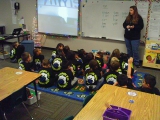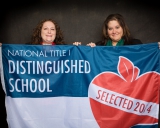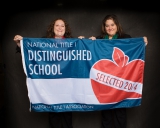-
Category 2
Selected in 2014
-
Grades: k - 5
School Setting: suburban
Town Population: 450
Student Enrollment: 545
Student Demographics:
Black/African American: 22%
Teacher/Student Ratio: 1:23
White/Caucasian: 22%
Hispanic: 45%
Hawaiian/Pacific Islander: 2%
Asian: 1%
Native American: 1%
Other: 7%
% Reduced Lunch: 93%
% ELL Learners: 23%
Founded: 1972 -
PRINCIPAL:
Kim Noyes -
CONTACT:
1860 South Chelton Road
Colorado Springs, CO 80910
719-579-2155
knoyes@hsd2.org
Centennial Elementary School
Colorado Springs, CO
A piece of power from the data board is that every teacher and administrator knows how each student is performing and everyone holds each other accountable to ensure EVERY student makes progress.
- Describe specific programs in place to ensure that families are involved in the success of your school and students.
- Families are a huge part to the success seen at Centennial Elementary. As a stakeholder of the school, we ask parents to support our mission of Achievement NOW by having their child read at home, come to school on time, and complete his/her homework at home. We host monthly parent involvement nights and anchor all nights to learning providing parents with ways that they can help at home. These monthly parent nights are hands on learning opportunities with activities parents can take home and use while helping their students at home. Our focus is always on partnering with parents to ensure they know how to help their students be successful at school. In addition, we have several times throughout the year where we celebrate the achievement of students and families are invited to the celebrations so we can honor them and their hard work as well. Parents are important stakeholders at Centennial Elementary.
- Describe the most successful activity your school has initiated to strengthen ties to your community.
- We have worked hard over the past 3 years to increase our community partnerships. We are proud to say that we have increased from 1 community partnership to 11 community partnerships. In doing so, we have been able to secure additional resources for our families, and we have been able to allocate funds that would have gone towards fieldtrips and school supplies on other things such as after school tutoring and our summer school program. Our biggest community sponsors are The Street Soldierz Motorcycle Club and The McDivitt Law Firm. Both organizations make regular contributions of resources for students and learning. In addition, both organizations volunteer their time to help our school with special events.
- Describe your philosophy of school change or improvement.
- The philosophy of change at Centennial was to create a culture of high expectations with accountability and support. All stakeholders had to buy in to our new mission of Achievement Now and be accountable for helping reach the mission. We used the gradual release model for assisting with planning and ensuring teachers could create meaningful lesson plans that were focused on key objectives. We also focused on increasing our communication with parents around achievement and ways that they can support learning at home. We worked collaboratively with staff and parents to create a uniting mission geared at improving achievement. Our school mission of Achievement NOW has helped us prioritize what is needed to make learning and achievement the priority.
- What are your school’s top two goals for the next year?
- Writing across the curriculum and deepening our system for data analysis are 2 school goals for next year. Writing across the curriculum will help us prepare our students for college and beyond. Ensuring students can transfer information that they read about into their writing will help ensure that students are able to analyze and apply their skills. Deepening our focus on analyzing data will help us ensure that we are able to put effective interventions in place for students who are struggling as well as challenge students who are demonstrating mastery of skills. Our staff is focused on increasing the data that students are using during their learning to ensure that they are monitoring their own learning.
- What is the single most important factor in the success of your school that others could replicate?
- The single most important factor in the success of your school that others can replicate is putting a systemic instructional schedule with no down time in place to maximize student learning. Three years ago we revamped the entire instructional schedule to maximize student learning time. We set up key instructional blocks and built the schedule out from there. In addition, we focused our attention on reading the first year and then moved to other subjects. We gave reading a priority as it is a gateway skill to learning in all areas. Every teacher has a reading block of at least 120 minutes daily. In addition, we put in a departmentalized schedule for the rest of the day so 2 teachers in each grade focus on math and two focus on writing. This minimizes what teachers have to plan and prepare for allowing them to be experts of the subject area. Finally, all students have an intervention block. This system of instruction had the greatest positive effect on student achievement.
- Describe the program or initiative that has had the greatest positive effect on student achievement, including closing achievement or opportunity gaps, if applicable.
- One of the greatest initiatives that had a positive effect on students achievement was the system that was put in place for instruction. Three years ago we revamped the entire instructional schedule to maximize student learning time. We set up key instructional blocks and built the schedule out from there. In addition, we focused our attention on reading the first year and then moved to other subjects. We gave reading a priority as it is a gateway skill to learning in all areas. Every teacher has a reading block of at least 120 minutes daily and support pushes in including SPED teachers, ELD teachers, Specials teachers, and paraprofessionals. In addition, we put in a departmentalized schedule for the rest of the day so 2 teachers in each grade focus on math and the other two focus on writing. This minimizes what teachers have to plan and prepare for allowing them to be experts of the subject area. Finally, all students have an intervention block. This system of instruction had the greatest positive effect on student achievement.
- Explain how Title I funds are used to support your improvement efforts.
- Title I funds are maximized at Centennial, and our staff attributes much of our success to our purposeful use of Title I funds. We are very deliberate in how we spend these funds. We use funds in several ways. We have used some funds to expand our after school tutoring program and provide a summer literacy academy to additional students. This has allowed 100 students to attend extra tutoring and 200 to attend summer school. We have also used funds to expand our hands on learning opportunities. This has been in the form of supplies to make hands on learning come alive and technology (via Smart Boards and laptops) to help students interact with the real world while in our classrooms.
- Identify the critical professional development activities you use to improve teaching and student learning.
- Professional development must be purposeful and systemic. We developed a two year professional development plan that focused on ensuring good first instruction for all students. We have provided extensive professional development around unpacking standards into meaningful lessons, engagement strategies, using the gradual release model, and using data to drive instruction. As part of our professional development most recently, we are focused on incorporating language rich strategies into our instruction. A key to the success of our professional development has been the focused approach with trainings targeted to specific groups of teachers, grade levels, or subjects depending on the topic and need.
- Describe how data is used to improve student achievement and inform decision making.
- Data helps drive decisions at Centennial Elementary. We use multiple pieces of data to make instructional decisions for both individual students and classes as a whole. Something we pride ourselves on is our data board that resides in the Principal’s office. The board has a magnet for each student for reading, writing, and math and is color coded to show the student’s current level of performance. During grade level meetings, teachers and administrations use this information to discuss student progress. From this information next steps are determined for individual or whole group interventions or instructional changes. A piece of power from the data board is that every teacher and administrator knows how each student is performing and everyone holds each other accountable to ensure EVERY student makes progress.
- Describe your school culture and explain changes you’ve taken to improve it.
- The school culture at Centennial Elementary is one of high expectations. Multiple things were implemented to make this change. A culture shift to believe that all students can succeed occurred with the creation of a new mission focused on “Achievement Now.” Along with the new mission statement came the support to reach the goal. Staff, students, and parents all agreed to do whatever it took to reach high levels of achievement. For staff, this meant targeted professional development with multiple classroom observations to ensure high quality instruction. For students, this meant giving their best and knowing the work is hard but the staff will support you. For parents, this meant getting students to school on time every day, reading with them at night, ensuring they completed their homework, and attended tutoring or summer school. All of these stakeholders working together to hold each other to high expectations transformed the school culture at Centennial.
Stats
-
Category 2
Selected in 2014
-
Grades: k - 5
School Setting: suburban
Town Population: 450
Student Enrollment: 545
Student Demographics:
Black/African American: 22%
Teacher/Student Ratio: 1:23
White/Caucasian: 22%
Hispanic: 45%
Hawaiian/Pacific Islander: 2%
Asian: 1%
Native American: 1%
Other: 7%
% Reduced Lunch: 93%
% ELL Learners: 23%
Founded: 1972 -
PRINCIPAL:
Kim Noyes -
CONTACT:
1860 South Chelton Road
Colorado Springs, CO 80910
719-579-2155
knoyes@hsd2.org









